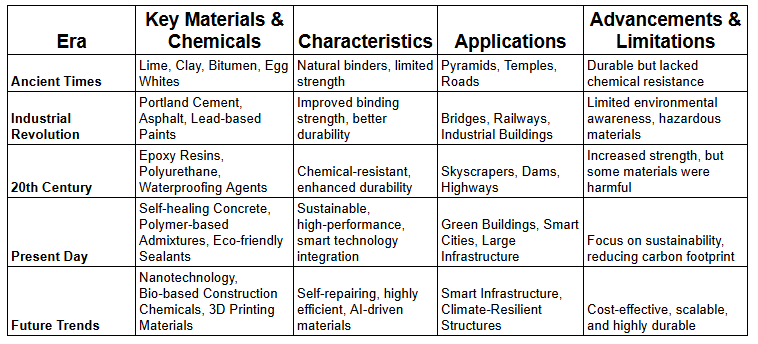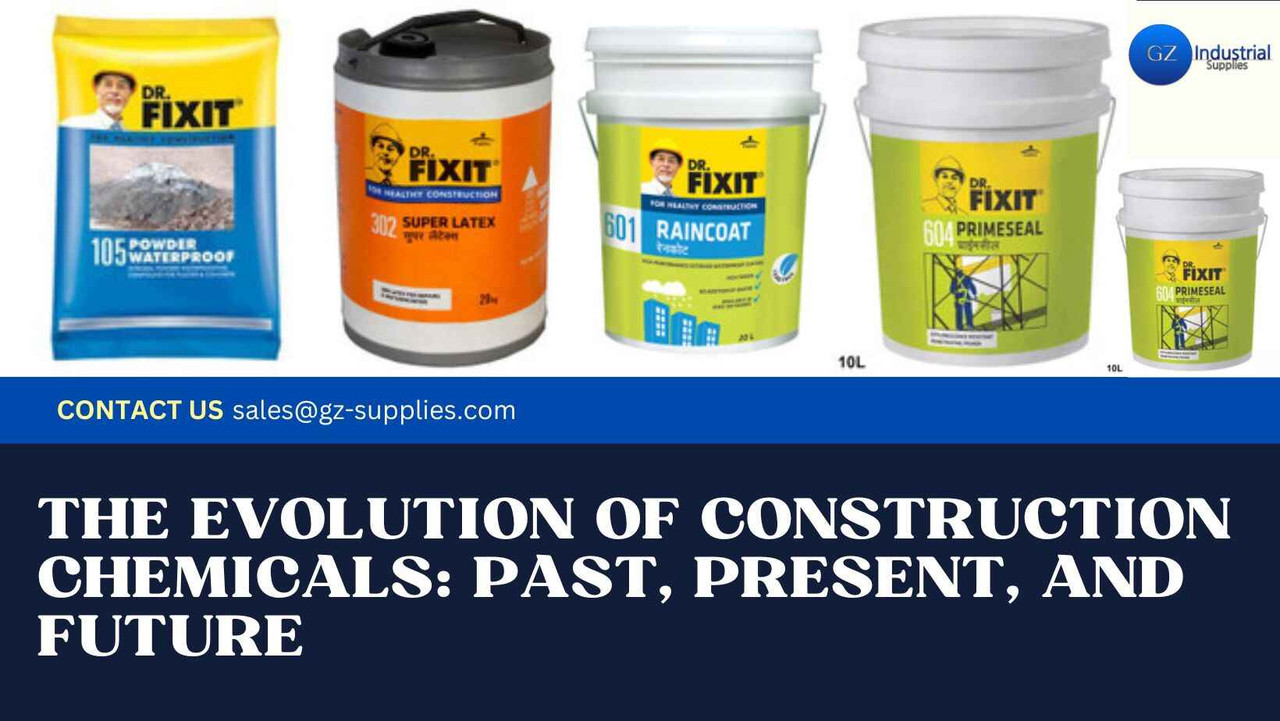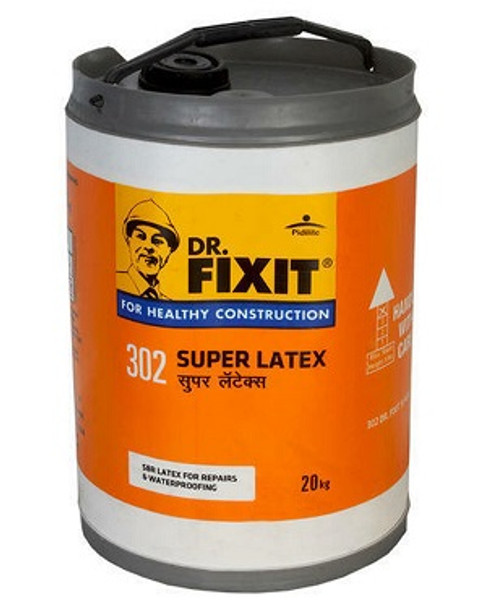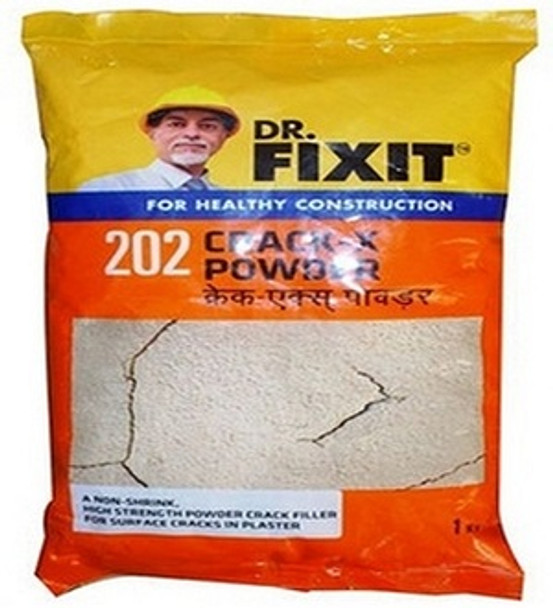The Evolution of Construction Chemicals: Past, Present, and Future
Introduction
Construction chemicals have always been playing important roles in virtually all sorts of construction projects, be it industrial projects, residential building projects, commercial building projects and so on. These chemicals are often used in various elements of projects in order to achieve various important qualities such as workability, durability etc. Construction chemicals exist in many varieties from a large number of manufacturers worldwide.
Read more...Why Quality Construction Chemicals are Crucial for your Projects
Key Takeaway
- Historical Advancements – Early civilizations used natural materials like lime, clay, and animal-based binders to enhance construction durability.
- Industrial Revolution Impact – The 19th and 20th centuries saw the introduction of Portland cement, concrete admixtures, and synthetic polymers, transforming construction.
- Modern Innovations – Today’s construction chemicals, including epoxy resins, waterproofing agents, and polymer-modified mortars, improve strength, durability, and efficiency.
- Sustainability Trends – The industry is shifting towards eco-friendly, low-VOC, and energy-efficient materials to meet green building standards.
What is Construction Chemicals
Construction chemicals are chemical formulations used with masonry materials, cement, concrete or other construction materials at the time of construction to hold the construction materials together. Let's take a quick trip through time to see how construction chemicals have changed. In the past, construction relied on simple yet effective materials like lime, bitumen, and basic mixes to lay the groundwork for buildings. These early solutions, though straightforward, formed the foundation of construction.
Fast forward to the present day, and we're witnessing a revolution in construction chemicals. Advanced concrete admixtures, waterproofing agents, and protective coatings have become the go-to toolkit for builders. These specialized formulations enhance strength, durability, and aesthetics, offering solutions to diverse construction challenges. Looking into the future, the trajectory of construction chemicals points towards even more innovation. Nano-materials, self-healing substances, and eco-friendly formulations are on the horizon. Imagine construction chemicals that not only strengthen structures but also contribute to sustainability and environmental well-being.
In essence, from the basic building blocks of the past to the sophisticated formulations of today and the groundbreaking innovations of tomorrow, the evolution of construction chemicals tells a tale of continual improvement and adaptability in the ever-evolving world of construction.
As we explore the story of construction chemicals, we'll look at how these chemicals have made buildings better. From the basics in the past to the high-tech formulas today, the journey of construction chemicals is a transformation that has made our buildings stronger and more amazing. So, let's dive into this journey of building better, one chemical at a time.
Buy Online…Dr. Fixit Krystalline 107 – the ultimate waterproofing treatment for concrete.
Past: Foundations of Construction Chemicals
Early Use of Basic Materials in Construction
The history of construction is as old as human civilization itself. Early humans utilized natural materials available in their environment to build shelters and structures. These materials included mud, stone, wood, and leaves, each chosen for its availability, durability, and ease of use. Mud bricks, for instance, were used due to their accessibility and ease of shaping. Similarly, the use of lime, derived from limestone, dates back centuries and was employed as a binding agent in mortar and plaster, marking one of the earliest instances of chemical use in construction.
Introduction of Rudimentary Construction Chemicals
As human understanding of chemistry progressed, rudimentary chemicals emerged in construction. The Romans, known for their advanced engineering, introduced mixtures like pozzolanic cement, blending volcanic ash with lime to create a durable binder for structures like aqueducts and buildings. This innovation laid the groundwork for modern cement production techniques. Additionally, bitumen, a naturally occurring substance extracted from petroleum, was used by ancient civilizations as a waterproofing agent and adhesive in construction, showcasing an early use of organic chemicals in building practices.
Historical Developments Shaping the Early Industry
Several historical events and advancements significantly shaped the early construction chemicals industry. The Industrial Revolution, for instance, marked a pivotal era with the mass production of chemicals and the mechanization of various processes. This led to the creation of synthetic materials, enabling the development of new construction chemicals that enhanced durability, strength, and performance of building materials. Furthermore, the introduction of reinforced concrete in the mid-19th century revolutionized construction practices, requiring innovative chemicals to ensure the longevity and structural integrity of these composite materials. This period also saw the rise of steel as a construction material, allowing for the creation of skyscrapers and expansive bridges, forever changing the skyline of cities around the world.
Read more...How to Choose the Right Construction Chemicals
Buy Online… Dr. Fixit 302 Super Latex: Strengthen and waterproof your structures with ease.
The Evolution of Construction Chemicals: Past, Present, and Future

Read more...Which Construction Chemical is used for Waterproofing?
Present: Technological Advancements and Current Trends
Key Advancements in Construction Chemical Formulations
In recent decades, the development of construction chemicals has seen remarkable advancements driven by technology and scientific innovation. New formulations have emerged, integrating nanotechnology, polymers, and specialized additives to enhance the performance and properties of construction materials. For instance, nano-additives are being incorporated into concrete to improve its strength, durability, and resistance to environmental factors. Polymer-based chemicals like Superplasticizers have also gained prominence, offering improved adhesion, flexibility, and waterproofing capabilities in various construction applications.
Moreover, the evolution of admixtures in concrete has allowed for better workability, reduced water content, and enhanced curing, leading to structures with increased strength and durability. Chemicals designed for corrosion protection, fire resistance, and energy efficiency have become integral in modern construction practices, reflecting a shift toward more durable and sustainable building solutions.
Diverse Applications and Uses in Modern Construction
Construction chemicals today find diverse applications across the construction industry. They are used in structural engineering, infrastructure development, residential and commercial buildings, and even in renovation and restoration projects. Waterproofing solutions, for instance, have expanded beyond traditional applications to include innovative membranes, coatings, and sealants that protect structures from moisture entry, extending the lifespan of buildings and infrastructure.
Furthermore, the use of construction chemicals extends to surface treatments, such as coatings and finishes, enhancing beauty while providing protective layers against environmental degradation. Specialty chemicals cater to specific needs, including concrete repair and rehabilitation, ensuring the longevity and safety of existing structures.
Influence of Technology and Sustainability in the Present Era
Technology has significantly influenced the development of sustainable construction chemicals. With a growing focus on environmental impact and resource efficiency, manufacturers are striving to create eco-friendly formulations that reduce carbon footprints and minimize waste. Sustainable construction chemicals such as green concrete and recycled aggregate materials incorporate bio-based materials, recycled content, and low-emission formulations, aligning with global efforts toward eco-conscious construction practices.
Additionally, advancements in digitalization and data-driven solutions have streamlined the production, application, and monitoring of construction chemicals. Real-time monitoring systems and predictive analytics enable better quality control, optimization of materials, and improved project management, contributing to overall sustainability and efficiency in the construction sector.
Buy Online… Dr. Fixit Construction Foam: Multi-purpose polyurethane foam for sealing, insulation, and soundproofing.
Future Trends: Innovations and Sustainability
Emerging Technologies in Construction Chemical Research
The future of construction chemicals is poised for groundbreaking advancements through cutting-edge technologies. Nanotechnology is expected to play a pivotal role, enabling the development of smarter materials with enhanced properties. Nanoparticles designed to improve concrete strength, durability, and self-healing capabilities are anticipated to become more prevalent, offering solutions that can autonomously repair cracks and increase the longevity of structures.
Furthermore, ongoing research in additive manufacturing, commonly known as 3D printing, holds promise for customized construction solutions using specialized chemical compositions. This technology could revolutionize on-site construction by allowing for intricate designs and optimized material usage, reducing waste and construction time.
Innovations in materials science, such as the utilization of carbon-negative or carbon-neutral materials, are being explored to reduce the carbon footprint of construction chemicals. Bio-based polymers, recycled aggregates, and sustainable additives are being investigated to create eco-friendly alternatives that maintain or improve performance while minimizing environmental impact.
Anticipated Trends in Formulations for Sustainability
Future formulations of construction chemicals are expected to prioritize sustainability and eco-friendliness even further. Manufacturers are likely to focus on reducing the use of harmful chemicals and volatile organic compounds (VOCs) in their products, thereby promoting healthier indoor air quality and reducing environmental pollution.
Biodegradable and renewable materials are projected to gain traction, offering solutions that break down naturally over time, reducing waste accumulation and environmental harm. Moreover, the concept of circular economy principles is expected to influence the design of construction chemicals, emphasizing recyclability and the use of recycled content in formulations.
Additionally, the development of "smart" construction chemicals that can adapt to changing environmental conditions, such as temperature, moisture, and stress, is on the horizon. These materials may have the ability to self-regulate, leading to increased efficiency and reduced maintenance requirements for constructed assets.
Potential Impacts on the Construction Industry
The future trajectory of construction chemicals will likely have far-reaching impacts on the construction industry. As sustainable practices and environmental regulations become more stringent, the demand for eco-friendly construction chemicals is anticipated to surge. This shift may drive innovation and investment in research and development, fostering a more sustainable and resilient built environment.
Moreover, the adoption of advanced construction chemical technologies is poised to optimize construction processes, improving efficiency, and reducing costs. Enhanced durability and longevity of structures through innovative materials may lead to reduced maintenance requirements and extended service life, resulting in substantial economic benefits for infrastructure owners and developers.
However, the integration of these novel technologies and sustainable formulations will necessitate collaboration among stakeholders, including manufacturers, regulators, builders, and designers, to ensure proper implementation and adherence to industry standards. Ultimately, the evolution of construction chemicals toward innovative and sustainable solutions holds the potential to reshape the construction industry, fostering a greener and more resilient built environment for future generations.
Buy Online… Dr. Fixit 202 Crack-X Powder: The quick fix for wall cracks and imperfections.
Challenges and Opportunities
Current Challenges Faced by the Construction Chemicals Industry
The construction chemicals industry faces several challenges that impact its operations and growth. One primary challenge involves the complexity of regulatory compliance and varying standards across different regions. Adhering to diverse regulatory frameworks regarding safety, environmental impact, and quality assurance often poses logistical and financial hurdles for manufacturers operating globally.
Another significant challenge is the need for continuous innovation and research to meet evolving demands for sustainable and high-performance materials. Balancing the requirement for innovative solutions while maintaining cost-effectiveness remains a constant challenge. Additionally, market fragmentation and competition intensify as new entrants and existing players vie for market share, creating pricing pressures and potential commoditization of certain products.
Moreover, the industry grapples with the perception of construction chemicals as commodities rather than value-added products. This perception often leads to price-driven purchasing decisions, hindering the adoption of advanced, sustainable, and higher-performing chemical solutions.
Opportunities for Growth and Improvement
Despite challenges, the construction chemicals industry also presents significant opportunities for growth and improvement. The increasing global focus on sustainable development and infrastructure presents a vast opportunity for manufacturers to invest in eco-friendly, innovative formulations. Growing urbanization, coupled with infrastructure development in emerging economies, offers a substantial market for construction chemicals. Furthermore, the rising demand for high-performance materials that ensure durability, energy efficiency, and reduced maintenance costs provides an avenue for manufacturers to differentiate their products. Opportunities exist in developing specialized chemicals tailored to meet the demands of specific applications, such as in smart cities, renewable energy infrastructure, and advanced building technologies.
The integration of digital technologies, such as sensors, big data analytics, and machine learning, presents opportunities to enhance product development, optimize supply chains, and provide value-added services like predictive maintenance for constructed assets.
The Role of Innovation in Overcoming Challenges
Innovation stands as a key driver in overcoming the challenges faced by the construction chemicals industry. It plays a crucial role in developing solutions that address several issues within the sector. Research and development efforts focused on creating advanced materials that offer superior performance while meeting environmental standards are essential. Moreover, innovation in production processes, such as green manufacturing techniques and efficient resource utilization, can reduce the environmental footprint of chemical production.
Innovation also extends to marketing strategies and value communication, emphasizing the added benefits of advanced construction chemicals beyond mere cost, thereby shifting the perception from commodities to value-added products.
Ultimately, a commitment to innovation, coupled with strategic investments in research, development, and sustainable practices, will enable the construction chemicals industry to navigate challenges effectively and capitalize on opportunities for growth and improvement.
Buy Online... Dr. Fixit 113 Fastflex: For a waterproof seal on Damp areas and pools.
Related Article;
What are Construction Chemicals ?
Where to Buy Construction Chemicals in Nigeria
Conclusion
The evolution of construction chemicals has played a pivotal role in shaping modern infrastructure, from ancient materials to today’s high-performance solutions. As the industry advances, the focus on sustainability, durability, and smart technologies continues to drive innovation. Understanding these trends helps professionals make informed decisions, ensuring stronger, longer-lasting, and eco-friendly structures.
For top-quality construction chemicals that meet the demands of today’s projects, explore our extensive range of products. Shop Now at GZ Supplies and get the best solutions for your construction needs!











